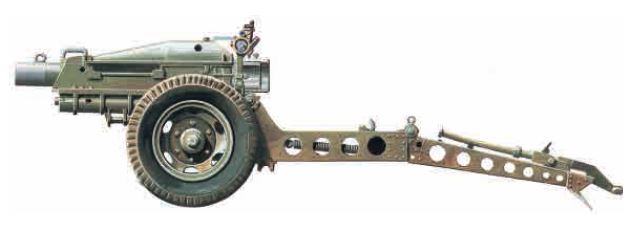Michael E. Haskew
Nicknamed “Little Dynamite”, the 75mm pack howitzer proved its worth with the 1st Battalion, 10th Artillery in support of the Marines on Tarawa. Under the command of Lieutenant Colonel Presley Rixey, the 75mm pack howitzer fired 2366 rounds at Japanese targets during the four-day fight for the islet of Betio. Developed in the early 1920s by the U.S. Army and standardized in 1927 as the M1 pack howitzer, the weapon could be broken down into several components. Rear trail and axle, front trail, top sleigh and cradle, bottom sleigh and recoil mechanism, breech and wheels, and tube.

These could be carried by men or pack animals and assembled in the field. The gun was light at 1439lb (653kg) and capable of an impressive rate of fire of five rounds per minute with a maximum range of about 5.4 miles (8.7km). At Tarawa, the Marines of the 1st Battalion, brought their howitzers ashore under heavy enemy fire. Traversing the waist-deep water of the lagoon and then crossing the exposed pier to reach firing positions. Shortly after assembling the weapons, the artillerymen went to work. First they blasted away at Japanese strong-points. Early on the second day of fighting, they destroyed two enemy bunkers that had been raking elements of the 8th Marines as they struggled toward the shore. The howitzers were also instrumental in breaking up a Japanese Banzai charge against the 6th Marines on the third night of the battle.
Over 8000 75mm Pack Howitzer cannons were produced
While the fighting raged the Marines were under continuous enemy fire, but served their 75mm pack howitzer artillery steadily. Rixey and 1st Lieutenant Norman Miller, a forward observer who directed highly accurate fire, received the Silver Star for their heroic actions at Betio. By the time the islet was secured, seven Marines of the 1st Battalion, had been killed and 18 wounded. During the course of World War II, heavier weapons of 105mm and 155mm were introduced in Marine artillery units. However, the versatile “Little Dynamite” remained in service to the end of the conflict. When production ceased in 1944, more than 8000 had been produced.
Michael E. Haskew is the editor of WWII History Magazine and the former editor of World War II Magazine . He is the author of a number of books, including THE MARINES IN WORLD WAR II. The Sniper at War and Order of Battle. Haskew is also the editor of The World War II Desk Reference with the Eisenhower Center for American Studies. He lives in Hixson, Tennessee.
